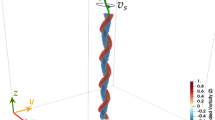Abstract
When a heat flux is switched on across a fluid binary mixture, steady state conditions for the temperature and mass concentration gradients ∇T and ∇c are reached via a diffusive transient process described by a series of terms “modes” involving characteristic times τ n . These are determined by static and transport properties of the mixture, and by the boundary conditions. We present a complete mathematical solution for the relaxation process in a binary normal liquid layer of heightd and infinite diameter, and discuss in particular the role of the parameterA=k 2 T (∂μ/∂c) T,P /TC P,c coupling the mass and thermal diffusion. Herek T is the thermal diffusion ratio, (∂μ/∂c) −1 T,P is the concentration susceptibility, μ is the chemical potential difference between the components, andC P,c is the specific heat. We present examples of special situations found in relaxation experiments. WhenA is small, the observable times τ(∇T) and τ(∇c) for temperature and concentration equilibration are different, but they tend to the same value asA increases. We present experimental results on four examples of liquid helium of different3He mole fractionX, and discuss these results on the basis of the preceding analysis. In the simple case for pure3He (i.e., in the absence of mass diffusion) we find the observed τ(∇T) to be in good agreement with that calculated from the thermal diffusivity. For all the investigated3He-4He mixtures, we observe τ(∇c) and τ(∇T) to be different whenA is small, a situation occurring at high enough temperatures. AsA increases with decreasingT, they become equal, as predicted. For the mixtures with mole fractionsX(3He)=0.510 and 0.603, we derive the mass diffusionD from the analysis of τ(∇c) and demonstrate that it diverges strongly with an exponent of about 1/3 in the critical region near the superfluid transition. As the tricritical point (T t,X t) is approached for the mixtureX=X t0.675,D tends to zero with an exponent of roughly 0.4. These results are consistent with predictions and also with theD derived from sound attenuation data. We discuss the difficulties of the analysis in the regime close toT λ andT t, with special emphasis on the situation created by the onset of a superfluid film along the wall of the cell forX=0.603 and 0.675.
Similar content being viewed by others
References
L. D. Landau and I. M. Lifshitz,Fluid Mechanics (Pergamon Press, London, 1959), Chapter VI.
H. L. Swinney and D. L. Henry,Phys. Rev. A 8, 2586 (1973); J. V. Sengers and J. M. H. Levelt-Sengers, inProgress in Liquid Physics, C. A. Croxton, ed. (Wiley, Chichester, U.K., 1978), p. 103.
G. Ahlers and F. Pobell,Phys. Rev. Lett. 32, 144 (1974).
R. P. Behringer and G. Ahlers,Phys. Lett. 62A, 329 (1977).
G. Ruppeiner and H. Meyer,Phys. Lett. 70A, 433 (1979); G. Ruppeiner, M. Ryschkewitsch, and H. Meyer,J. Low Temp. Phys. 41, 179 (1980).
M. Tanaka and A. Ikushima,J. Low Temp. Phys. 35, 9 (1979); A. Ikushima,Japan. J. Appl. Phys. 19, 2315 (1980).
G. Ahlers,Phys. Rev. Lett. 24, 1333 (1970).
R. P. Behringer and H. Meyer,J. Low Temp. Phys., this issue, next article.
I. M. Khalatnikov,Introduction to the Theory of Superfluidity (Benjamin, New York, 1965), Section 24.
A. Griffin,Can. J. Phys. 47, 429 (1969).
G. Ahlers, inThe Physics of Liquid and Solid Helium, Part I, K. H. Bennemann and J. B. Ketterson, eds. (Wiley, New York, 1976).
G. Goellner, R. P. Behringer, and H. Meyer,J. Low Temp. Phys. 13, 113 (1973).
R. B. Griffiths,Phys. Rev. Lett. 24, 715 (1970); E. K. Riedel,Phys. Rev. Lett. 28, 675 (1972).
E. K. Riedel, H. Meyer, and R. P. Behringer,J. Low Temp. Phys. 22, 369 (1976).
E. D. Siggia and D. R. Nelson,Phys. Rev. B 15, 1427 (1977).
F. M. Gasparini and M. R. Moldover,Phys. Rev. B 12, 93 (1975).
T. Takada and T. Watanabe,J. Low Temp. Phys. 41, (1980).
F. M. Gasparini and A. A. Gaeta,Phys. Rev. B 17, 1466 (1978).
T. A. Alvesalo, P. M. Berglund, S. T. Islander, G. R. Pickett, and W. Zimmermann, Jr.,Phys. Rev. A 4, 2354 (1971).
S. T. Islander and W. Zimmermann, Jr.,Phys. Rev. A 7, 188 (1973).
M. G. Ryschkewitsch and H. Meyer,J. Low Temp. Phys. 35, 103 (1979).
C. A. Gearhart and W. Zimmerman, Jr.,Phys. Rev. B 19, 2677 (1979).
P. Leiderer, D. R. Watts, and W. W. Webb,Phys. Rev. Lett. 33, 483 (1974).
H. A. Kierstead,J. Low Temp. Phys. 35, 25 (1979).
M. K. Grover and J. Swift,J. Low Temp. Phys. 11, 751 (1973).
K. Kawasaki and J. D. Gunton,Phys. Rev. Lett. 29, 1661 (1972).
D. B. Roe, G. Ruppeiner, and H. Meyer,J. Low Temp. Phys. 27, 747 (1977).
S. G. Lipson, J. Landau, and N. Bochner, inProc. International Conference on Low Temperature Physics LT15 (Grenoble, 1978).
J. F. Kerrisk and W. E. Keller,Phys. Rev. 177, 341 (1969).
Author information
Authors and Affiliations
Additional information
Work supported by grants from the National Science Foundation and the Research Corporation and by an A. P. Sloan fellowship to one of the authors (RPB).
Rights and permissions
About this article
Cite this article
Behringer, R.P., Meyer, H. Diffusive relaxation processes in liquid3He-4He mixtures. I. Normal phase. J Low Temp Phys 46, 407–434 (1982). https://doi.org/10.1007/BF00683908
Received:
Issue Date:
DOI: https://doi.org/10.1007/BF00683908




